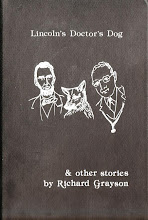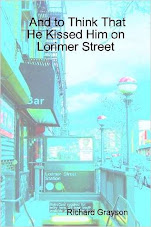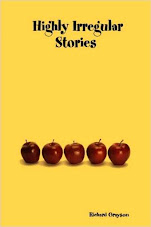
This afternoon we were lucky enough to see The Bent Quill Players' boisterously funny production of Molière's A Doctor in Spite of Himself at the Music Pagoda at Prospect Park. Directed by Eli Thacker Taylor and featuring a talented cast, the play caused us to laugh out loud at least half a dozen times, and we're normally a lot more dour.

This was the fifth play we've seen at the Music Pagoda in the past couple of years, and it's a wonderful setting, leafy and comfortable and low-key. Today there was little of the noise competition from elsewhere we've noticed in the past (just a couple of times we heard the dim hum of a motorized scooter).

It's best to bring a blanket or towel to sit on, because the ground isn't that grassy in the best of times, and we'd suggest leaving early to give yourself enough time to find the Music Pagoda; the signs aren't that clear, even when you locate the place on the park map, and as many times as we've been here, we always manage to make at least one wrong move and have to backtrack on the paths to the site.

Last year we saw our first Bent Quill Players production, in Fort Tryon Park in Washington Heights, where they presented Susanna Centlivre's 1709 comedy The Busybody, which was absolutely delightful. Today's Molière play featured the same high-quality acting and fast-paced and innovative direction, with more accomplished musical accompaniment and probably more hearty laughs. (Interestingly, Centlivre wrote her own take on Le Médecin Malgré Lui, titled Love's Contrivance, so obviously the two playwrights share similar sensibilities.)

As the Merriam-Webster's Encyclopedia of Literature notes in its entry on "comedy of intrigue":
The Doctor in Spite of Himself [1666], which begins as a farce based on the simple joke of mistaking the ne'er-do-well woodcutter Sganarelle for a doctor, gradually becomes a satire on learned pretension and bourgeois credulity as Sganarelle fulfills his role as a doctor with great success. The Doctor in Spite of Himself, which begins as a farce based on the simple joke of mistaking the ne'er-do-well woodcutter Sganarelle for a doctor, gradually becomes a satire on learned pretension and bourgeois credulity as Sganarelle fulfills his role as a doctor with great success.

The Bent Quill Players used Aurand Harris's sharpened 1968 adaptation of Moliere's play in a cleverly directed production. Like all the other plays we've seen at the Music Pagoda, they employed both the raised stage of the pagoda itself and the space in front of it (and around the sides, especially well-used during fast-paced, hilarious chase scenes). The well-crafted and whimsical original music was created by Patrick Metzger, who on banjo was joined by Tamara Jaton on violin and Curtis McMurtry on saxophone, to provide some moments that perfectly highlighted the comic business of the actors.
We were impressed with the black, white and gray costume design of company co-founder Meaghan Cross as well as the cleverness of the props, which were farcical and outlandish enough to deflect and lighten what might otherwise be somewhat uncomfortable moments for an audience sensitive to physical violence in general and spousal abuse in particular.

The comedy works on several levels, most broadly as slapstick farce (what the little kids can appreciate) as well as quite sophisticated and still sharply relevant satire, as Sganarelle's delicious commentary on his success as a Catch-Me-If-You-Can medical fraud (here in another translation):
I find it the best of trades; for, whether we are right or wrong, we are paid equally well. We are never responsible for the bad work, and we cut away as we please in the stuff we work on. A shoe maker in making shoes can't spoil a scrap of leather without having to pay for it, but we can spoil a man without paying one farthing for the damage done. The blunders are not ours, and the fault is always that of the dead man. In short, the best part of this profession is, that there exists among the dead an honesty, a discretion that nothing can surpass; and never as yet has one been known to complain of the doctor who had killed him.
Molière himself played this part, and today Alessandro King gave a wonderfully modulated performance as the increasingly less reluctant and more assured fake physician, managing to seem at once the dopey, lazy woodcutter and the sly trickster who gets the better of his social betters and everyone else foolish or desperate enough to believe in him while he convincingly plays both the woman-chasing lout and the cupid reuniting thwarted young lovers. Like many of the performances, King's was both broadly comic and surprisingly touching.

The ensemble of Meaghan Cross, Norah Elise Johnson and Katharine Tool in their French chambermaid outfits and Owen Scott as a kind of slightly sinister Cabaretesque MC did yeoman's duty keeping the somewhat loose plot strands together. Leah Weingart, as Martine, Sganarelle's wife who is as much a trickster and ultimately a softy as her good-natured husband, seemed simultaneously feisty and, in the end, well worth giving up fantasy for.

Last year, in The Busybody, Nevan Scott expertly played the father of the ingenue, determined to keep her from marrying her true love in favor of a more wealthy potential son-in-law. Here he employs a slightly more intelligent version of the same character type in his portrayal of Geronte, keeping apart his daughter Lucinde (a charming, insouciant faker of muteness, Jillian Nicole Barrels) and her stolid, handsome young boyfriend, played deftly by Nathan Wiley. All three actors prove surprisingly good at physical comedy, as does the entire cast, as the play turns from satire to Keystone Kops-style hijinks.

Hico Oshiro as the excitable Lucas and Marri J. Wright as Valere are the pair of Geronte's hyper-excitable servants who forcefully enlist Sganarelle into the medical profession, and in the role of Jacqueline, Lucas's wife and the object of Sganarelle's lust, the droll Giverny Petitmerment is clearly the only one onstage who's clear-headed and intelligent enough to understand exactly what's going on at any one time. Eli Thacker Taylor's direction
Compared to Molière's more trenchant "major" comedies, like The Misanthrope, Tartuffe, The School for Wives or The Imaginary Invalid (which we saw a great production of way back in 1980 right here in Park Slope, in one of the Seventh Avenue churches, with our friend the playwright Judd Lear Silverman playing Cleante), some might consider A Doctor in Spite of Himself to be a slightly lesser effort.

We've never thought so (we liked the play enough so that in 2002 when we were asked to write -- for a cool thousand dollars -- an autobiographical essay for Contemporary Authors, we called it "A Writer in Spite of Myself"), and today in Prospect Park, under Eli Thacker Taylor's expert and multi-layered direction, the Bent Quill Players had us even more convinced that presented right, it's a first-rate comedy of its time, and yeah, of our own time, too.

If you can get to Prospect Park tomorrow (Sunday, May 1), you too can enjoy the fun of this classic French comedy, which is appropriate for all ages -- the kids around us were really entertained by it -- at 1 p.m. and 4 p.m. It will also be playing next Friday, May 6, at 4 p.m. and next Saturday, May 7, at 1 p.m. and 4 p.m.











































































